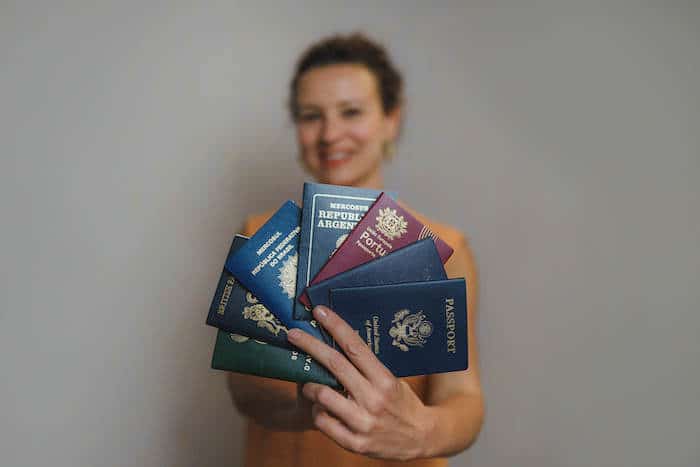Global Citizen Solutions has launched its second, revised 2023 Global Passport Index, providing a comprehensive tool that allows individuals to discover a passport’s true strength.
Using the same meticulous research and data collection techniques as for our 2022 Global Passport Index, our revised edition offers a cutting-edge insight into the most powerful passports of today.
And we couldn’t have done it without our data expert consultants, Roberto and Vlad, the pioneers behind the whole methodology. Aside from their shared interest in numbers and kilts, Roberto and Vlad bond over composite indicators—key mathematical aggregations used in this index to determine a passport’s power. We sat down with the masterminds to learn about the concept behind the Global Passport Index and how it fares compared to existing Passport Indexes globally.


For some, seeing Germany ranked as the most powerful passport in the world may come as a surprise. Can you explain how you came to this conclusion?
It is a matter of striking a balance and performing well in all three indices. Germany is not the highest-ranked passport in any of the three, however, the country does perform well in each. Comparing it with the best-placed passport in terms of mobility, Singapore, which also tops the ranking in terms of investment, we find that while Germany is ranked 5th in quality of life, Singapore is much lower, at 108th position. In the Quality of Life Index, Germany fares better than Singapore, with a score of 83.3, while Singapore has a score of 58.3. For instance, a lower cost of living, a low level of migrant acceptance, and the Freedom in the World Report, one of the sources we use, classify Singapore as only partly free. Singapore, therefore, comes out as having the 13th strongest passport in the world, when combining the three indexes. Germany's strength comes in performing well in each standalone index. As we mentioned, Germany ranks in 5th position in the Quality of Life Index, but also ranks highly in the other two: 3rd in the Enhanced Mobility Index and 11th in the Investment Index. Given that Germany is an economic powerhouse with the highest number of expats in Europe, it's not that much of a surprise that Germany takes the top spot in the 2023 Global Passport Index.What makes this Global Passport Index different from others?
Firstly, it goes beyond the simple counting of visa-free access countries by valuing each destination that a passport gives enhanced access to. Moreover, it also gives partial credit to simplified procedures such as Electronic Travel Authorization (eTA), on-arrival visas, and Electronic Visas. Secondly, it covers several dimensions that might be impactful for those deciding to live abroad, be they retirees, expats, students, or those moving out of necessity. And finally, it provides three standalone indices that could cater to different interests.How did you both search for reliable sources for the passport index project?
As part of the overall Global Passport Index, the Enhanced Mobility Index focused on the merits of a passport and its primary purpose as a travel document. Therefore, in this dimension, the qualities of the issuing country or territory should not take part in the index, as they are covered in the other dimensions. Instead, the focus should fall on the destinations and how easy it is to access them. The development process was centered on how to combine ease of access with the evaluation of destinations, and how to assess each destination. After careful consideration, the Quality of Life Index was used as the basis to evaluate destinations, as it already covers many of the attributes that make a country or territory attractive to travel to. In the adapted approach, for each of the two domains (Investment and Quality of Life), a number of orienting questions were selected. These questions initially served to direct the search for relevant indicators. Finally, cost-benefit and coverage analyses were made in deciding which indicators to retain. For the Investment dimension, the goal set was to “assess a country’s attractiveness as an investment opportunity for passport holders.” The set of orienting questions was:- What is the personal income tax rate [at the highest bracket/median]?
- How attractive is the country for direct investment?
- How easy is it to conduct business in the country?
- How functional is the legal system?
- How strong is the economy?
- Is it politically stable?
- What is the overall level of human development/general population quality of life?
- How happy is the country’s population?
- How good is healthcare? How affordable is good healthcare?
- How safe is living in the country?
- How good is education?
- How good is it as a travel hub?
- What is the level of freedom experienced by the country’s population?
- How attractive is the country in terms of natural resources, environment? (e.g, air quality, biodiversity etc)
- What is the level of ICT connectivity?
How did you choose between possible alternatives?
We favored indicators:- from reliable sources;
- with reasonable update history and future perspective;
- that encapsulated many of the target dimensions and could potentially address several questions;
- which provided “added-value” in relation to already selected indicators.


